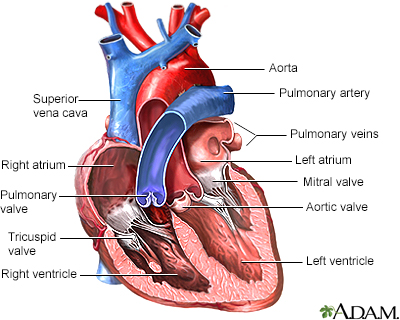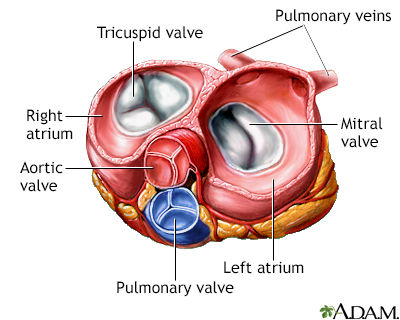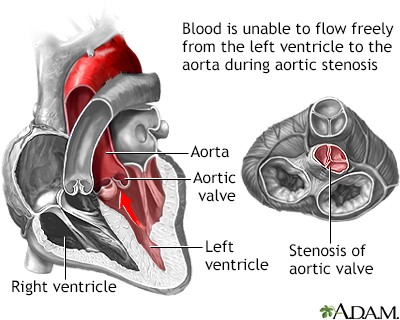Aortic valve surgery - open
Aortic valve replacement; Aortic valvuloplasty; Aortic valve repair; Replacement - aortic valve; AVR
Blood flows out of your heart and into a large blood vessel called the aorta. The aortic valve separates the heart and aorta. The aortic valve opens so blood can flow out. It then closes to keep blood from returning to the heart.
You may need aortic valve surgery to replace the aortic valve in your heart if:
- Your aortic valve does not close all the way, so blood leaks back into the heart. This is called aortic regurgitation.
- Your aortic valve does not open fully, so blood flow out of the heart is reduced. This is called aortic stenosis.
Open aortic valve surgery replaces the valve through a large cut in your chest.
The aortic valve can also be replaced using minimally invasive aortic valve surgery. This is done using several small cuts.
Images



Description
Before your surgery you will receive general anesthesia. You will be asleep and pain free.
- Your surgeon will make a 10-inch-long (25 centimeters) cut in the middle of your chest.
- Next, your surgeon will divide your breastbone to be able to see your heart and aorta.
- You may need to be connected to a heart-lung bypass machine or bypass pump. Your heart is stopped while you are connected to this machine. This machine does the work of your heart while your heart is stopped.
If your aortic valve is too damaged, you will need a new valve. This is called valve replacement surgery. Your surgeon will remove your aortic valve and sew a new one into place. There are two main types of new valves:
- Mechanical, made of man-made materials, such as titanium or carbon. These valves last the longest. You may need to take blood-thinning medicine, such as warfarin (Coumadin) for the rest of your life if you have this type of valve.
- Biological, made of human or animal tissue. These valves may last 10 to 20 years, but you may not need to take blood thinners for life.
Once the new valve is working, your surgeon will:
- Close your heart and take you off the heart-lung machine.
- Place catheters (tubes) around your heart to drain fluids that build up.
- Close your breastbone with stainless steel wires. It will take about 6 to 12 weeks for the bone to heal. The wires will stay inside your body.
This surgery may take 3 to 5 hours.
Sometimes other procedures are done during open aortic surgery. These include:
- Coronary bypass surgery
- Aortic root replacement (David procedure)
- Ross (or switch) procedure
Why the Procedure Is Performed
You may need surgery if your aortic valve does not work properly. You may need open-heart valve surgery for these reasons:
- Changes in your aortic valve are causing major heart symptoms, such as chest pain, shortness of breath, fainting spells, or heart failure.
- Tests show that changes in your aortic valve are beginning to seriously harm how well your heart works.
- Your heart valve has been damaged by infection of the heart valve (endocarditis).
- You have received a new heart valve in the past and it is not working well.
- You have other problems such as blood clots, infection, or bleeding.
Risks
Risks for any surgery are:
- Blood clots in the legs that may travel to the lungs
- Blood loss
- Breathing problems
- Infection, including in the lungs, kidneys, bladder, chest, or heart valves
- Reactions to medicines
Possible risks from having open heart surgery are:
- Heart attack or stroke
- Heart rhythm problems
- Incision infection, which is more likely to occur in people who are obese, have diabetes, or have already had this surgery
- Infection of the new valve
- Kidney failure
- Memory loss and loss of mental clarity, or "fuzzy thinking"
- Poor healing of the incision
- Post-pericardiotomy syndrome (low-grade fever and chest pain) that could last up to 6 months
- Death
Before the Procedure
Always tell your health care provider:
- If you are or could be pregnant
- What medicines you are taking, even drugs, supplements, or herbs you bought without a prescription
You may be able to store blood in the blood bank for transfusions during and after your surgery. Ask your provider how you and your family members can donate blood.
If you smoke, you must stop. Ask your provider for help.
For the 1 week period before surgery, you may be asked to stop taking medicines that make it harder for your blood to clot. These might cause increased bleeding during the surgery.
- Some of these drugs are aspirin, ibuprofen (Advil, Motrin), and naproxen (Aleve, Naprosyn).
- If you are taking warfarin (Coumadin), clopidogrel (Plavix), or other blood thinning medicines, talk with your surgeon before stopping or changing how you take these drugs.
During the days before your surgery:
- Ask which medicines you should still take on the day of your surgery.
- Always let your provider know if you have a cold, flu, fever, herpes breakout, or any other illness in the time leading up to your surgery.
Prepare your house for when you get home from the hospital.
Shower and wash your hair the day before your surgery. You may need to wash your whole body below your neck with a special soap. Scrub your chest 2 or 3 times with this soap.
On the day of your surgery:
- You will most often be asked not to drink or eat anything after midnight the night before your surgery. This includes using chewing gum and breath mints. Rinse your mouth with water if it feels dry. Be careful not to swallow.
- Take the medicines you have been told to take with a small sip of water.
- You will be told when to arrive at the hospital.
After the Procedure
Expect to spend 4 to 7 days in the hospital after surgery. You will spend the first night in the ICU and may stay there for 1 to 2 days. There will be 2 to 3 tubes in your chest to drain fluid from around your heart. These are usually removed 1 to 3 days after surgery.
You may have a catheter (flexible tube) in your bladder to drain urine. You may also have intravenous (IV) lines to deliver fluids. Nurses will closely watch monitors that display your vital signs (your pulse, temperature, and breathing).
You will be moved to a regular hospital room from the ICU. Your heart and vital signs will continue to be monitored until you go home. You will receive pain medicine to control pain around your surgical cut.
Your nurse will help you slowly resume some activity. You may begin a program to make your heart and body stronger.
You may have a pacemaker placed in your heart if your heart rate becomes too slow after surgery. It may be temporary or permanent.
Outlook (Prognosis)
Mechanical heart valves do not fail often. However, blood clots can develop on them. If a blood clot forms, you may have a stroke. Bleeding can occur, but this is rare.
Biological valves have a lower risk of blood clots, but tend to fail over an extended period of time. For best results, choose to have your aortic valve surgery at a center that does many of these procedures.
Related Information
Marfan syndromeEndocarditis
Congenital heart defect - corrective surgery
Pediatric heart surgery
Aortic valve surgery - minimally invasive
Pediatric heart surgery - discharge
Aspirin and heart disease
Antiplatelet medicines - P2Y12 inhibitors
Heart valve surgery - discharge
Taking warfarin
References
Lindman BR, Bonow RO, Otto CM. Aortic valve stenosis. In: Libby P, Bonow RO, Mann DL, Tomaselli GF, Bhatt DL, Solomon SD, eds. Braunwald's Heart Disease: A Textbook of Cardiovascular Medicine. 12th ed. Philadelphia, PA: Elsevier; 2022:chap 72.
Rosengart TR, Aberle CM, Ryan C. Acquired heart disease: valvular. In: Townsend CM Jr, Beauchamp RD, Evers BM, Mattox KL, eds. Sabiston Textbook of Surgery. 21st ed. St Louis, MO: Elsevier; 2022:chap 61.
BACK TO TOPReview Date: 1/23/2023
Reviewed By: Mary C. Mancini, MD, PhD, Cardiothoracic Surgeon, Shreveport, LA. Review provided by VeriMed Healthcare Network. Also reviewed by David C. Dugdale, MD, Medical Director, Brenda Conaway, Editorial Director, and the A.D.A.M. Editorial team.

Health Content Provider
06/01/2025
|
A.D.A.M., Inc. is accredited by URAC, for Health Content Provider (www.urac.org). URAC's accreditation program is an independent audit to verify that A.D.A.M. follows rigorous standards of quality and accountability. A.D.A.M. is among the first to achieve this important distinction for online health information and services. Learn more about A.D.A.M.'s editorial policy, editorial process and privacy policy. A.D.A.M. is also a founding member of Hi-Ethics. This site complied with the HONcode standard for trustworthy health information from 1995 to 2022, after which HON (Health On the Net, a not-for-profit organization that promoted transparent and reliable health information online) was discontinued. |
The information provided herein should not be used during any medical emergency or for the diagnosis or treatment of any medical condition. A licensed medical professional should be consulted for diagnosis and treatment of any and all medical conditions. Links to other sites are provided for information only -- they do not constitute endorsements of those other sites. © 1997- 2025 A.D.A.M., a business unit of Ebix, Inc. Any duplication or distribution of the information contained herein is strictly prohibited.
